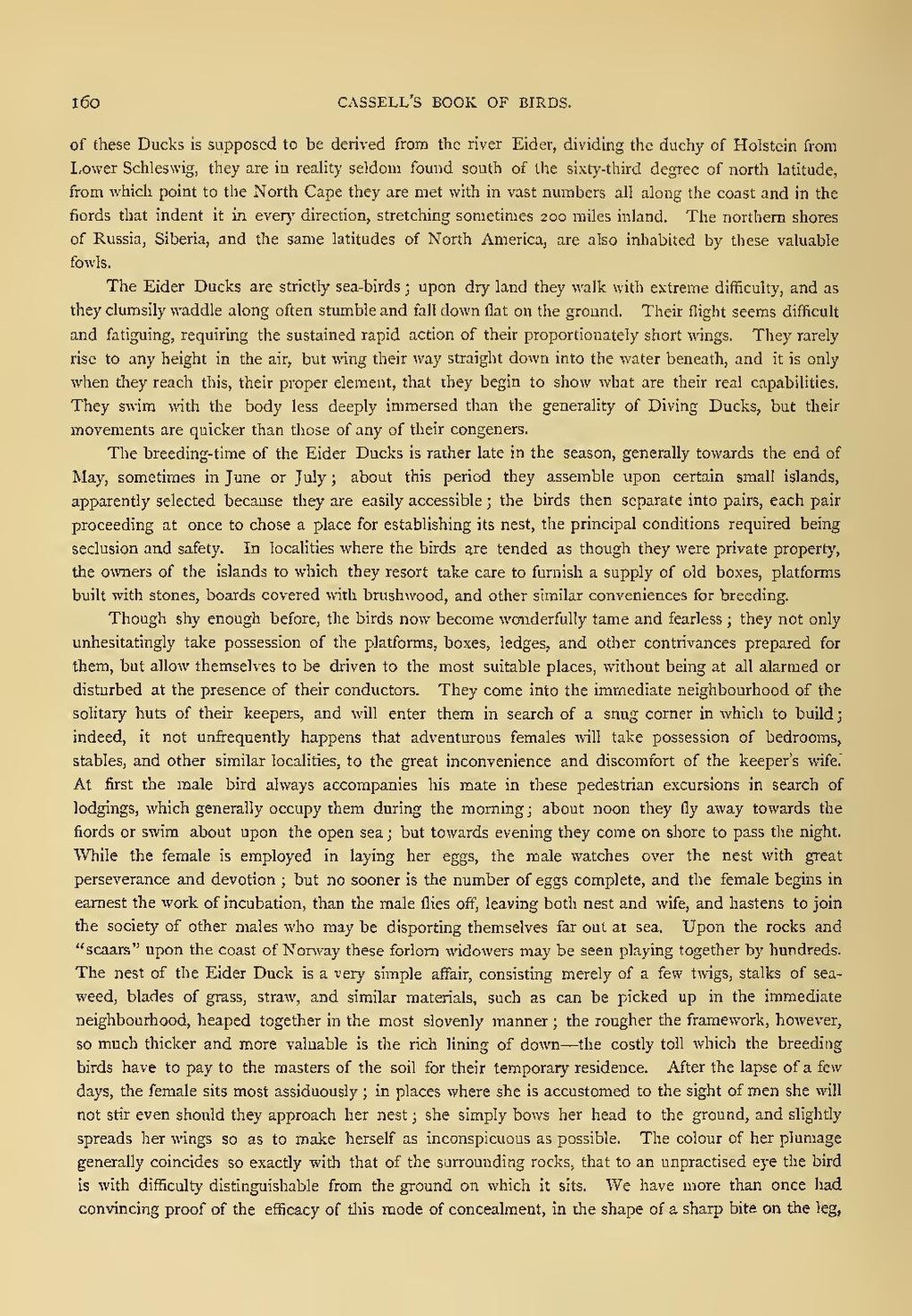of these Ducks is supposed to be derived from the river Eider, dividing the duchy of Holstein from Lower Schleswig, they are in reality seldom found south of the sixty-third degree of north latitude, from which point to the North Cape they are met with in vast numbers all along the coast and in the fiords that indent it in every direction, stretching sometimes 200 miles inland. The northern shores of Russia, Siberia, and the same latitudes of North America, are also inhabited by these valuable fowls.
The Eider Ducks are strictly sea-birds; upon dry land they walk with extreme difficulty, and as they clumsily waddle along often stumble and fall down flat on the ground. Their flight seems difficult and fatiguing, requiring the sustained rapid action of their proportionately short wings. They rarely rise to any height in the air, but wing their way straight down into the water beneath, and it is only when they reach this, their proper element, that they begin to show what are their real capabilities. They swim with the body less deeply immersed than the generality of Diving Ducks, but their movements are quicker than those of any of their congeners.
The breeding-time of the Eider Ducks is rather late in the season, generally towards the end of May, sometimes in June or July; about this period they assemble upon certain small islands, apparently selected because they are easily accessible; the birds then separate into pairs, each pair proceeding at once to chose a place for establishing its nest, the principal conditions required being seclusion and safety. In localities where the birds are tended as though they were private property, the owners of the islands to which they resort take care to furnish a supply of old boxes, platforms built with stones, boards covered with brushwood, and other similar conveniences for breeding.
Though shy enough before, the birds now become wonderfully tame and fearless; they not only unhesitatingly take possession of the platforms, boxes, ledges, and other contrivances prepared for them, but allow themselves to be driven to the most suitable places, without being at all alarmed or disturbed at the presence of their conductors. They come into the immediate neighbourhood of the solitary huts of their keepers, and will enter them in search of a snug corner in which to build; indeed, it not unfrequently happens that adventurous females will take possession of bedrooms, stables, and other similar localities, to the great inconvenience and discomfort of the keeper's wife. At first the male bird always accompanies his mate in these pedestrian excursions in search of lodgings, which generally occupy them during the morning; about noon they fly away towards the fiords or swim about upon the open sea; but towards evening they come on shore to pass the night. While the female is employed in laying her eggs, the male watches over the nest with great perseverance and devotion; but no sooner is the number of eggs complete, and the female begins in earnest the work of incubation, than the male flies off, leaving both nest and wife, and hastens to join the society of other males who may be disporting themselves far out at sea. Upon the rocks and "scaars" upon the coast of Norway these forlorn widowers may be seen playing together by hundreds. The nest of the Eider Duck is a very simple affair, consisting merely of a few twigs, stalks of seaweed, blades of grass, straw, and similar materials, such as can be picked up in the immediate neighbourhood, heaped together in the most slovenly manner; the rougher the framework, however, so much thicker and more valuable is the rich lining of down—the costly toll which the breeding birds have to pay to the masters of the soil for their temporary residence. After the lapse of a few days, the female sits most assiduously; in places where she is accustomed to the sight of men she will not stir even should they approach her nest; she simply bows her head to the ground, and slightly spreads her wings so as to make herself as inconspicuous as possible. The colour of her plumage generally coincides so exactly with that of the surrounding rocks, that to an unpractised eye the bird is with difficulty distinguishable from the ground on which it sits. We have more than once had convincing proof of the efficacy of this mode of concealment, in the shape of a sharp bite on the leg,
